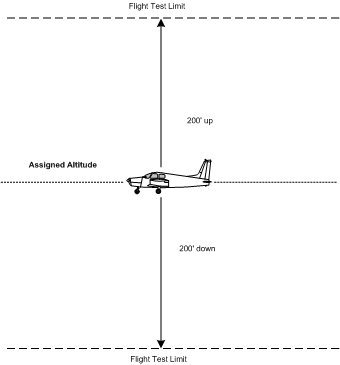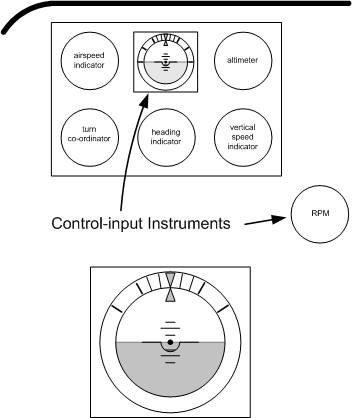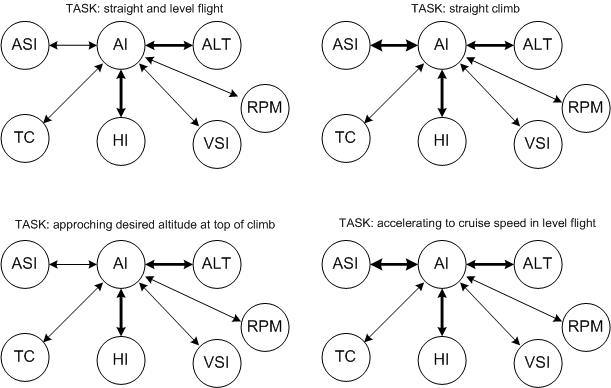
INSTRUMENT FLYING
This exercise does not apply to Recreation Pilot Students. Note the variations in requirements for Private Pilot and Commercial Pilot Students, as indicated below.
Private Pilot Students
Full Panel
Aim
Private Pilot Students must demonstrate their ability to control and manoeuvre the aircraft solely by reference to flight instruments.
Description
With sole reference to the flight instruments, Private Pilot Students will be asked to:
- maintain co-ordinated straight and level flight for 2 minutes;
- carry out a level rate-one turn through 180° to a reciprocal compass heading and, on completion;
- maintain co-ordinated straight and level flight for a further 2 minutes.
Performance Criteria
Private Pilot Students will control and manoeuvre the aircraft within
- ± 15° of the assigned heading;
- ± 200’ of the assigned altitude;
- ± 15 knots of the assigned airspeed;
- an angle of bank not to exceed the limit of the turn and bank indicator or turn co-ordinator.

Recovery from Unusual Attitude
Aim
Private Pilot Students must demonstrate the ability to promptly recover, using all flight instruments, from an unusual attitude.
Description
Using all available flight instruments, students will be required to promptly recover with a minimum loss of altitude from an unusual attitude.
Performance Criteria
Private Pilot Students must
- recognize promptly what the aircraft is doing by reference to the flight instruments;
- take immediate and correct recovery action;
- recover smoothly with a minimum loss of altitude, and without excessive airspeed;
- maintain co-ordinated flight.
Discussion
Use the turn co-ordinator to smoothly establish the standard rate turn; maintain a selective radial scan and avoid fixation; use a light touch on the controls; and don’t forget to trim. The key to instrument flying is moving the instrument panel (which is “moving the aeroplane”) slowly and smoothly—the reason why we do this is that the instrument panel is loaded with flight instruments that suffer from “lag”—all of the pitot-static family (airspeed indicator, altimeter, and vertical speed indicator). By moving the controls smoothly and slowly, you will succeed in minimizing the effects of these errors.1
Performance and Control Instruments

With respect to the selective radial scan, it is important to recognize that that the six flight instruments are divided into two—performance instruments, and control instruments. The control instruments are comprised of the attitude indicator and the power indicator (i.e., the RPM gauge). The attitude indicator, with respect to control column inputs, is really the “king” of all instruments. When you want to adjust the attitude of the aircraft, this is the one you use. In contrast, the remaining five instruments on the standard instrument panel are all performance instruments—they tell you what the inputs via the attitude indicator have actually done to the aircraft’s position in the air. All inputs are by way of the attitude indicator (and the RPM gauge), and all feedback (with respect to the effects of your inputs) come to you by way of the remaining performance instruments—the airspeed indicator, the altimeter, the turn-coordinator, the heading indicator, and the vertical speed indicator. Remember, though, that the attitude indicator is the main guy.
Selective Radial Scan

The Selective Radial Scan is technique or process of instrument scanning that is the most natural, comfortable, and effective. It draws attention to the fact that the attitude indicator is the hub of the scan pattern (control inputs), and that the pilot must selectively move between supportive instrument displays (control effects) depending on the flying tasks at hand. Accordingly, while attitude indicator information is supported by altimeter and heading indications in straight and level flight, the attitude indicator is supported by airspeed and heading indications during a straight climb.2
What the concept of Selective Radial Scan gives us is the notion that we must be flexible and—well—selective in our use of the supportive instruments that surround the attitude indicator. While the use of the attitude indicator for control-inputs does not change, the sources of information that we need to use to assess and evaluate the effects of our control-inputs does change, depending on the flying tasks we are attempting to accomplish.
Unusual Attitudes
During the flight test, the Examiner will take control of the aircraft, ask you to remove your hands and feet from the controls, and lower your head; the Examiner will then place the aircraft in an unusual attitude. Once this is done, the Examiner will say “You have control,” and you will be expected to look up at the panel as you take control, recognize the nature of the unusual attitude, and promptly input a solution. Some Examiners create a scenario where you are the pilot and they are your passenger, to whom you have given control. The passenger (who is flying) wants to “check-out” a house below and begins to circle and descend (inadvertently entering a spiral dive)—of course, the Examiner expects you to call “I have control!” and recover from the spiral dive.
 When you fly this exercise with your Instructor, it will not take long for you to figure out that there are only two types of unusual attitudes that can be thrown at you—the first is excessive nose-up, and the second is excessive nose-down. Both are potentially dangerous if not effectively recognized and rectified, with the nose-up attitude possibly leading to inadvertent stall/spin, and the nose-down attitude leading to an impending spiral dive. The corrective procedure is really straightforward. Firstly, power must be the absolute first priority—either the power must be applied fully (in the case of the impending stall), or must be reduced fully (in the case of a spiral dive). The second priority must be levelling the wings—this is the case in both the nose-up and the nose-down. The third priority—pitch—is not so straightforward. If a stall is imminent, there is no need to delay corrective pitch and the nose can be immediately lowered; in the case of the spiral dive, however, there is a real need to delay pitching the nose up until the wings are level—you do not want the added airframe stress of excessive “g” forces caused by trying to pitch-up using a non-vertical lift vector.
When you fly this exercise with your Instructor, it will not take long for you to figure out that there are only two types of unusual attitudes that can be thrown at you—the first is excessive nose-up, and the second is excessive nose-down. Both are potentially dangerous if not effectively recognized and rectified, with the nose-up attitude possibly leading to inadvertent stall/spin, and the nose-down attitude leading to an impending spiral dive. The corrective procedure is really straightforward. Firstly, power must be the absolute first priority—either the power must be applied fully (in the case of the impending stall), or must be reduced fully (in the case of a spiral dive). The second priority must be levelling the wings—this is the case in both the nose-up and the nose-down. The third priority—pitch—is not so straightforward. If a stall is imminent, there is no need to delay corrective pitch and the nose can be immediately lowered; in the case of the spiral dive, however, there is a real need to delay pitching the nose up until the wings are level—you do not want the added airframe stress of excessive “g” forces caused by trying to pitch-up using a non-vertical lift vector.
When faced with the unusual attitude, look first to both the attitude indicator and airspeed indicator. The attitude indicator can provide the “all-in-one” information necessary to rectify the unusualness of the aircraft’s attitude—but there is a problem with the attitude indicator in that it easily “topples” and it can therefore become useless. There is the chance, however, that the attitude indicator is working and you should consider this a gift. On the other hand, the airspeed is guaranteed to be working (even though it has the error of lag). The airspeed indicator provides immediate information on whether power should be increased or reduced. If you look up to see airspeed increasing (and it will do so rapidly), power must be immediately closed; if you see airspeed decreasing, full power must be immediately added.3 Simultaneously, the attitude indicator tells you immediately pitch and bank information. Any banked attitude should be immediately countered, with the levelling of the wings. Then, with a nose-up attitude, immediately pitch the nose down—this action can be done the instant the nose-up attitude is recognized; with a nose-down attitude defer pulling out of the dive until the wings are brought level—and then there should be no delay in smoothly but aggressively raising the nose.
In both cases—i.e., nose-up or nose-down unusual attitudes—the target is to place the aircraft in a controlled, full-power, normal climb attitude (once the aircraft is brought under control). Be sure you don’t set full power until the airspeed settles at the proper airspeed.
For Private Pilot Students, there is a variation on how the Instructor or Examiner sets up the unusual attitude exercise—and you should be ready for this one: the scenario is created whereby you are a licenced pilot and you are up flying with a friend. You pass control of the aircraft to your friend—i.e., the Instructor or Examiner—and the friend begins to circle over a ground point—say the friend’s house. The friend, however, is not a very good pilot (or is not a pilot) and the aircraft slowly but predictably enters a spiral dive. As pilot-in-command, you are expected to seize control (“I have control!”) of the aircraft and recover from the spiral dive.
Flight Safety
- The risk of collision is high during instrument training. As an extra precaution for collision avoidance, it required that a student under the hood verbally query the Instructor prior to executing a turn:
Student: |
“Is it clear to the right?” |
or |
Student: |
“Clear left?” |
Instructor: |
“Clear right.” |
Instructor: |
“Clear left.” |
- A HASEL check must be performed prior to practising unusual attitudes.
- Owing to the radical changes in direction and altitude associated with unusual attitudes, special consideration by the Instructor will be given to confirming that the airspace is clear before executing a turn.
- Safety with respect to traffic separation will be the responsibility of the Examiner during a flight test.
- Always double-check to ensure seatbelts are tight—coming out of the harness and ending up on top of the control column would be deadly.
1 The importance of smooth and slow application of the controls—control column, rudder pedals, and power changes—cannot be over emphasized; it is the key to advanced flying in general. There are times when rapid and aggressive control inputs are required—landing in a gusty crosswind, for example—but for the most part, smoothness rules. What is the difference between a pilot with 100 hours and a pilot with 5000 hours? Simply smoothness.
2 Note that in straight and level flight the primary source for pitch information is the altimeter, while during climbs and descents pitch information is derived from the airspeed indicator.
3 This is the one of those critical times when the power change must be made rapidly and aggressively. Remember that you could be less then seconds from a stall—or worse, less than 100’ from terrain in a screaming spiral dive. There is tremendous motivation to be aggressive with the power lever.

.jpg)

